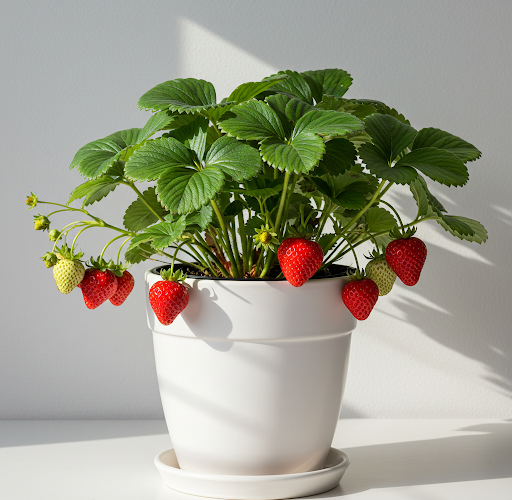How to Make an Effective Fertilizer for Strawberry Production
Strawberries are a delicious and rewarding fruit to grow, and with the right care, you can produce large, sweet strawberries right in your own garden or balcony. If you’re looking to boost your strawberry production, an effective fertilizer recipe can make all the difference. This guide will show you how to create a nutrient-rich fertilizer that promotes healthy strawberry growth and encourages abundant fruiting.
Key Nutrients for Strawberry Growth
Strawberries, like all plants, require essential nutrients for optimal growth. Three key nutrients that are vital for strawberry plants are nitrogen, potassium, and calcium. These nutrients help with leaf development, root growth, and overall plant health, ensuring the plant has enough energy to produce sweet, juicy strawberries.
-
Nitrogen is crucial for overall plant growth, especially for developing green, healthy leaves. It also plays a role in promoting flower and fruit production.
-
Potassium aids in the formation of sugars in the fruit, enhancing flavor and sweetness.
-
Calcium helps strengthen plant cell walls, ensuring the plant is strong and resilient, and prevents common issues like blossom end rot.
To create a balanced fertilizer, we’ll use some common ingredients that provide these nutrients.
Ingredients for the Fertilizer
-
Wood Ash: Wood ash is rich in potassium, calcium, and phosphorus. It is an excellent source of nutrients for fruiting plants like strawberries. For this recipe, you will need about 50 grams of wood ash. If you don’t have wood ash, you can use 15 grams of burned wood or another form of ash from a clean wood fire.
-
Composted Manure: Composted manure, particularly from cattle, is an excellent source of nitrogen. It also provides organic matter that improves soil structure and water retention. For this recipe, you’ll need 100 grams of well-composted manure. If possible, use chicken manure as it is even richer in nitrogen.
-
Water: Water is essential to dissolve the nutrients and make them available for the plant’s roots. You’ll need about 1 liter of water for this fertilizer mixture.
-
Milk: Milk is a fantastic source of calcium, which strawberries need for healthy fruit development. You will need about half a cup of milk for this mixture. If you don’t have milk, you can substitute with crushed eggshells, which also provide calcium.
Step-by-Step Instructions
-
Prepare the Ingredients: Start by mixing 50 grams of wood ash and 100 grams of composted manure in a container. These ingredients will provide the essential nutrients, including nitrogen, potassium, calcium, and phosphorus.
-
Add Water: Pour 1 liter of water into the mixture. Stir well to ensure the nutrients are properly dissolved in the water.
-
Add Milk: Add half a cup of milk to the mixture. Milk provides calcium, which is vital for the growth and fruiting of strawberries. Stir again to ensure the mixture is well combined.
-
Optional Ingredient – Crushed Eggshells: If you don’t have milk, you can substitute with about 50 grams of crushed eggshells. Crushed eggshells provide the necessary calcium and also improve the soil structure over time.
-
Ready to Apply: Once your fertilizer is mixed, it’s ready for application. Before using it, make sure to stir the mixture again to keep it well homogenized.
How to Apply the Fertilizer
To ensure your strawberries thrive, you should apply this fertilizer correctly:
-
Apply Around the Base of the Plant: Use the fertilizer around the base of the strawberry plants, avoiding direct contact with the roots. This helps provide the nutrients evenly throughout the soil.
-
Water After Application: After applying the fertilizer, water the soil to help the nutrients penetrate the ground and reach the roots. Be sure to water the plants thoroughly, but avoid creating puddles in the soil.
-
Fertilizer Frequency: You should apply this fertilizer every 10 days to ensure that your strawberries are getting consistent nutrients. If you apply too much at once, the milk can spoil, so always use fresh batches and avoid using it when it’s been left out for too long.
-
Proper Watering: Strawberries require a lot of water, especially when they are fruiting. Make sure to water your plants at least twice a day, especially in hot weather, to keep the soil moist and encourage healthy fruit development.
Additional Tips for Boosting Strawberry Production
-
Prune Runners: As strawberry plants grow, they produce runners (or stolons) that can take away energy from fruit production. For better results, remove these runners to encourage the plant to focus on fruiting rather than producing new plants.
-
Maximize Sun Exposure: While strawberries don’t enjoy excessive heat, they do need plenty of sunlight to thrive. Ensure that your strawberry plants get at least 6-8 hours of direct sunlight each day to maximize photosynthesis and energy production.
-
Maintain Healthy Soil: Ensure that the soil is well-draining and rich in organic matter. Adding compost or organic matter regularly can help maintain a fertile environment for your strawberry plants.
-
Harvesting: Once your strawberries begin to ripen, be sure to harvest them regularly. Picking ripe strawberries not only prevents them from overripening and attracting pests but also encourages the plant to produce more fruit.
Conclusion
With the right care and nutrients, you can enjoy a bountiful strawberry harvest. Using a homemade fertilizer with ingredients like wood ash, composted manure, milk, and water can provide your strawberries with the essential nutrients they need to grow strong, healthy plants that produce large, sweet strawberries. Regular feeding, proper watering, and some simple maintenance techniques will ensure that your strawberry plants flourish and provide you with a delicious harvest throughout the growing season.



